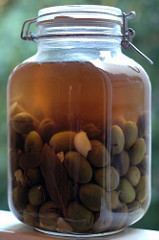Home-Cured Olives

Photo by Melissa Schneider.
An olive grove sits across one border of the orange farm my family owns, gray-green spiderwebs facing dark green puffs across a wide stretch of light tan dirt. Once, when I was "helping" with farmwork—a ten-year-old riding in the trailer and staying out of the way—my grandfather asked if I had ever tried an olive fresh from the tree. When I said no, he stopped the tractor pulling the flatbed trailer and urged me to pluck one from the neighbor's grove to my left.
Eating a raw olive is a once-in-a-lifetime event; you will never want to repeat it.
The uncured fruit has a bitterness that burns into your memory as it sucks the feeling from your mouth. But just as some distant, desperate eater once found their way to the heart of an artichoke, another learned that if you soak the olive in repeated changes of cold water, you wash away the harsh compounds and produce a bite-size morsel heavy with the taste of earth and grass.
Last December, I spied raw olives at Oakland's Market Hall and decided to cure them of their bitterness. Several of the books in my food and wine library offer instructions for brining olives, but the technique in Simple French Food doesn't use lye, which I didn't have at hand. Richard Olney's Provençal olive-curing recipe suggests that you crack the olives lightly with a mallet, cover them in cold water, and then drain and replenish that water every day for ten days. Finally, you create a simple hot brine (1/4 cup salt per quart of water) that covers the olives as well as the fennel fronds and garlic cloves you add for flavor.
Wait two weeks, says Olney, and enjoy.
Wait even longer, say I, and then enjoy. Two weeks after I placed the olives into the brine, they still tasted horrible. Not as bad as raw olives, but bad enough to trigger that long-ago memory of my grandfather's cruel trick. I worried the cure hadn't worked, but I decided to check the olives again a few weeks later. Olney had placed the olives in his cellar, and I thought my colder refrigerator had slowed down the leaching process.
Last week, the olives were transformed. They had a young, green, olive taste that you rarely find in commercial versions, with hints of garlic and fennel from the brine. Perhaps a touch of the original bitterness, but no more than that.
Of course, the state's olive harvest has already gone to the press or the canning factory, but if you spy some uncured olives next winter, pick up a pound or two and cure them yourself. And when you've eaten through your batch, use the brine for cookiecrumb's olive-pickled eggs.
Wine Notes
These olives make perfect lunchtime snacks or pre-dinner appetizers, and thus you want to serve them with a light, refreshing white wine that whets the appetite and doesn't overwhelm any wine that might follow. Because of the Provençal seasoning, I'm sure Olney would have urged a white or rosé wine from France's Bandol region. In fact, any similar wine from Provence or northwestern Italy would work just as well.
- California Olive Ranch Extra Virgin Olive Oil
It all comes down to freshness and quantity. California Olive Ranch plants three varieties, arbequina, arbosana from Spain and koroneiki from Greece. Their olive orchards look nothing like what you may have seen in Europe. The olive trees are pruned...
- Olive Oil Tasting
Olive oil has a lot in common with chocolate, wine and tea. Each has a long history, compelling health benefits and is a staple in just about every kitchen or dining room table. The more I learn about each, the more I realize how much more there is to...
- Crazy For Conservas
When I think of processed foods the first things that come to mind are newfangled convenience and artificial ingredients. But that's not the case with all processed foods. In Spain, preserving vegetables and seafood is a very traditional craft....
- Fig, Onion And Black Olive Tapenade:recipe
I get a lot of good ideas from reading Craigslist Food Forum. Recently I read about an olive fig tapenade that people seem to be raving about. Needing an appetizer that could survive for a few hours without refrigeration, I figured it would fit the bill....
- Trying New Things: Olives
Olives are one of the foods I’ve avoided for a very long time. They pop up from time to time in a salad, pizza or other dish ordered in a restaurant, but I typically pull them out before I start eating and pass them over to someone who appreciates them....
